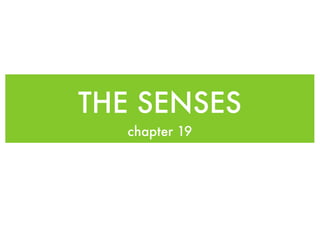
Senses anatomy project
- 1. THE SENSES chapter 19
- 2. RECEPTORS • -- Structures that detect stimuli. They monitor both external and internal environmental conditions. Conduct information about those stimuli to the central nervous system.
- 3. TYPES OF RECEPTORS • Chemoreceptors- they detect • Mechanoreptors- respond to chemicals. touch, pressure, vibration, & stretch. • Thermoreceptors- respond to changes in temperature. • Baroreceptors- detect changes in pressure within body • Photoreceptors- detect structures. changes in light intensity, color, & movement. • Nocieptors- respond to pain caused by either external or internal stimuli.
- 4. THE TONGUE
- 5. • Gustation is our sense of taste. It permits us to perceive the characteristics of what we eat and drink. • Gustatory cells are taste receptors housed in specialized sensory organs termed taste buds on the tongue surface.
- 6. • Detects five basic taste sensations: salty, sweet, sour, bitter, & umami • Facial Nerve - taste anterior 2/3 tongue • Glossopharyngeal Nerve - taste posterior 1/3 tongue
- 7. THE EYE
- 8. CONJUNCTIVA • Stratified squamous epithelium • Forms a continuous lining of the external, anterior surface of the eye • Contains numerous goblet cells which lubricates and moistens the eye
- 9. FIBROUS TUNIC • External layer of • Mostly formed by the eye wall. touch sclera • Composed of anterior cornea & posterior sclera. • contains no blood vessels
- 10. VASCULAR TUNIC • Middle layer of the eye wall. • also called “uvea” (grape) • composed of three regions: choroid, ciliary body, & iris
- 11. NERVES ASSOCIATED WITH THE EYE • OPTIC • OCULOMOTOR • TROCHLEAR • ABDUCENS
- 12. THE EAR
- 13. THE [[external]] EAR • A Skin covered cartilaginous structure called the auricle or pinna. • The Auricle is funnel shaped and serves to protect entry into the ear. • Directs sounds waves into the bony tube called the external acoustic meatus.
- 14. MIDDLE EAR
- 15. THE [[middle]] EAR • Contains an air filled tympanic cavity. • Includes the the bones from lateral to medial: Malleus, Incus, & Stapes. • Responsible for amplifying sound waves and transmitting them into the inner ear.
- 16. INNER EAR
- 17. THE [[inner]] EAR • Located within the petrous part of the temporal bone. • It includes the: vestibule, the semi circular canals, & the cochlea. • Mechanisms for equilibrium are located within the inner ear.
- 18. Nerves Associated With Inner Ear • VESTIBULOCOCHLEAR NERVE & THE VAGUS NERVE
- 19. the process of hearing
- 20. • 1) sound waves are collected and funneled by the auricle of the external ear. • 2) the vibrations of the tympanic membrane causes movement by the auditory ossicles. • 3) pressure waves originate within the inner ear and travel through the perilymph in the scala vestibuli. • 4) high-frequency and upper medium frequency pressure waves in the scala vestibuli cause the vestibular membrane to vibrate, resulting in pressure wave formation in the endolymph of the cochlear duct. • 5) the remaining pressure wave vibrations in the cochlear duct are transmitted to the perilymph of the scala tympani and they exit the inner ear at the round window.